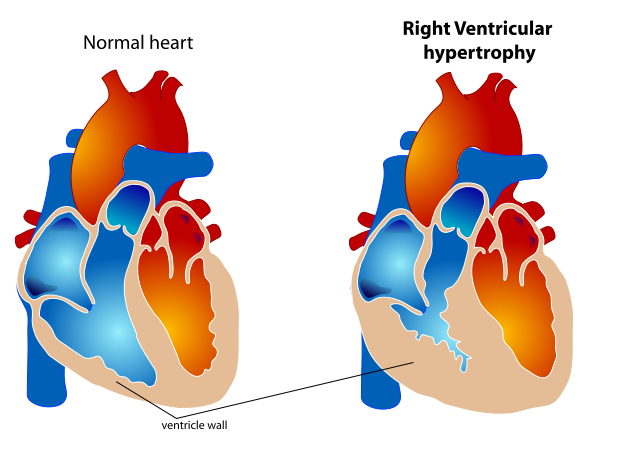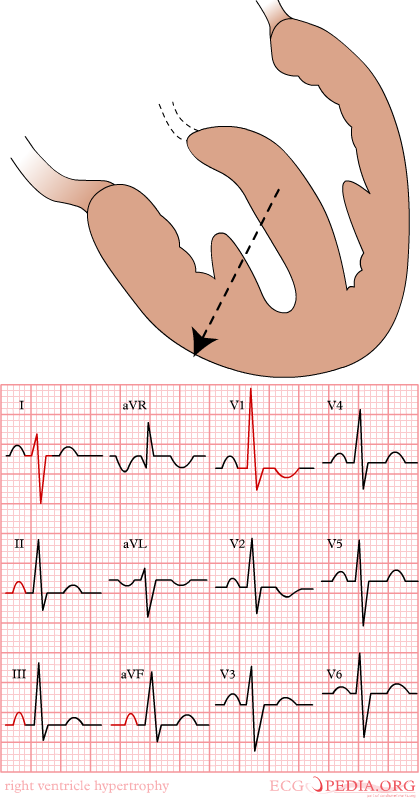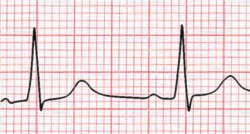Right ventricular hypertrophy
Jump to navigation
Jump to search
| Right ventricular hypertrophy | |
 | |
|---|---|
| Right Ventricular hypertrophy |
Editor-In-Chief: C. Michael Gibson, M.S., M.D. [1]; Associate Editor(s)-in-Chief: Ogheneochuko Ajari, MB.BS, MS [2]
Synonyms and keywords: RVH, RV strain
Overview
Right ventricular hypertrophy refers to thickening of the heart muscle of the right ventricle.
Pathophysiology
Blood travels through the right ventricle to the lungs. If there is increased resistance to flow in the pulmonary circulation, the stress placed on the right ventricle can lead to right ventricular hypertrophy.
Causes of Right Ventricular Hypertrophy
Life Threatening Causes
Life-threatening causes include conditions which may result in death or permanent disability within 24 hours if left untreated.
Common Causes
- Cardiac fibrosis
- Chronic obstructive pulmonary disease (COPD)
- Cystic fibrosis
- High altitude[1]
- Mitral stenosis[2]
- Pulmonary hypertension[2]
- Pulmonic regurgitation
- Pulmonic stenosis
- Tetralogy of Fallot
- Ventricular septal defect
Causes by Organ System
Causes in Alphabetical Order
Diagnosis
EKG Findings in Right Ventricular Hypertrophy

Shown below is a tracing from lead V1 which shows right ventricular hypertrohpy, with an R wave > the S wave in V1

Diagnostic Criteria for Right Ventricular Hypertrophy
- Right axis deviation of +90 degrees or more
- RV1 = 7 mm or more
- RV1 + SV5 or SV6 = 10 mm or more
- R/S ratio in V1 = 1.0 or more
- S/R ratio in V6 = 1.0 or more
- Late intrinsicoid deflection in V1 (0.035+)
- Incomplete RBBB pattern
- ST T strain pattern in 2,3,aVF
- P pulmonale or Right atrial enlargement or P congenitale
- S1 S2 S3 pattern in children
- Tall R wave in V1 or qR in V1
- R wave greater than S wave in V1
- R wave progression reversal
- Inverted T wave in the anterior precordial leads
Differential Diagnosis of R>S in V1
- RVH
- Posterior MI
- WPW
- HCM (septal hypertrophy)
- Kulbertus' block (septal fascicular block)
- Duchennes Muscular Dystrophy
- Normal variant
- V4r may be a more useful and reliable than lead V1 in that it often reveals an r>s while v1 remains normal
- An incomplete right bundle branch block in the right precordial chest leads may signal the development of RVH
- In the limb leads right axis deviation develops and at times prominent Q waves simulating an IMI appear in leads 2,3, and aVF.
- In children an S1 S2 S3 pattern (i.e. an S wave deeper than R in all 3 standard leads) is a reliable index of RVH
- RV strain can be seen in leads V1 and V2 but also in leads 2,3, aVF
References
- ↑ http://www.lib.mcg.edu/edu/eshuphysio/program/section4/4ch7/s4ch7_32.htm
- ↑ 2.0 2.1 2.2 2.3 Harrigan RA, Jones K (2002). "ABC of clinical electrocardiography. Conditions affecting the right side of the heart". BMJ. 324 (7347): 1201–4. PMC 1123164. PMID 12016190.
- ↑ Wood WC, Wood JC, Lower RR, Bosher LH, McCue CM (1975). "Associated coarctation of the aorta and mitral valve disease: nine cases with surgical correction of both lesions in three". J Pediatr. 87 (2): 217–20. PMID 125322.
- ↑ Whayne TF (2013). "Cardiovascular Medicine at High Altitude". Angiology. doi:10.1177/0003319713497086. PMID 23892441.
- ↑ Tartulier M, Boutarin J, Ritz B (1984). "Chronic pulmonary thromboembolism". G Ital Cardiol. 14 Suppl 1: 13–21. PMID 6534760.